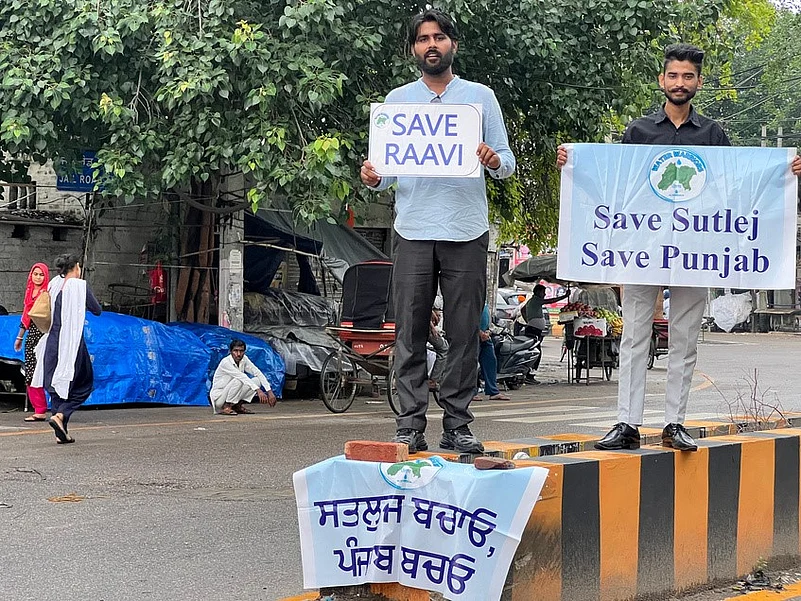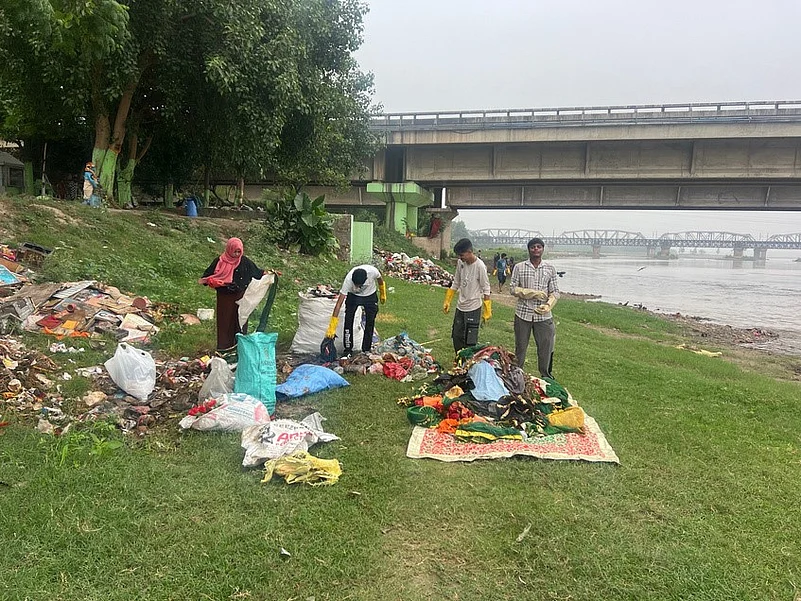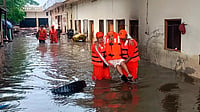If Raavi, Chenab and Satluj rivers could communicate, what would they say to each other? What stories would they share from the time when borders didn’t divide them? And what would they say about the present when polluted and toxic water is flowing through them?
Punjab—the land of five rivers—is presently grappling with severe river water contamination. The plight of these rivers is disheartening for me and Damanjeet Kaur, the co-author of this article. I come from Jammu and Kashmir, where these rivers originate, while Kaur is from Punjab, where they flow through and make the plains green and fertile.
Our shared concern for these rivers connects our personal histories to the larger environmental crisis. I remember my childhood in Jammu and Kashmir, watching the Chenab in Akhnoor, full of prosperity and life. At the same time, my co-author, growing up in Punjab, saw these rivers change from life-giving forces to symbols of decay. Once, they brought life and abundance, but now, they are polluted and burdened by the damage of neglect.
Yet, amid this crisis, we saw a glimmer of hope shining through the efforts taken by the youth of Punjab. We met Manjit Singh, the founder of the NGO Water Warriors Punjab, who left his position as an Assistant Professor to dedicate himself to saving these sacred rivers.
Singh’s journey toward water conservation began far from home, during his time when he was pursuing PhD in South India. “In Karnataka, I learned the true value of drinking water and conservation. Rivers there are rain-fed and not as continuously flowing as in Punjab,” he recalls.
Returning to Punjab, a land blessed with perennial rivers, he was shocked to see how far the situation had deteriorated. The water table was plummeting, rivers were being choked by industrial waste, and reverse boring was contaminating the groundwater. This crisis, compounded by the region’s changing crop patterns, painted a dire picture for the future. “When I saw people dumping waste into the Satluj river, it shook me. I had to act,” says Singh. Thus began the Water Warriors’ mission to restore Punjab’s rivers and awaken a new consciousness among its people.
With a dedicated team of 150 to 200 volunteers, Singh is actively cleaning the polluted stretches of the Satluj, Beas, and Raavi rivers in Ludhiana.
These volunteers, primarily the youth, come from all walks of life, but the unifying factor is their determination to save Punjab’s rivers from irreversible damage. Through awareness campaigns, clean-up drives, and community engagement, the Water Warriors have made significant strides. Their efforts are not only about removing physical waste from the rivers but also creating a psychological shift among Punjab’s youth and local communities. They have inspired a new generation to take ownership of their natural resources.
Despite initial challenges such as a lack of manpower and funding, Water Warriors has now garnered significant attention on social media, allowing them to grow their volunteer base. However, the task ahead remains daunting, with rivers being polluted almost as quickly as they are cleaned. Yet, Singh and his team remain undeterred, knowing that every small step brings them closer to a cleaner and greener Punjab. Their dream goes beyond merely cleaning the rivers—they aim to restore the water table, revive wetlands, and even develop green tourism around these restored ecosystems. Through their relentless campaigning and grassroots involvement, the water warriors have inspired a growing movement for environmental justice across Punjab, ensuring that future generations may one day witness the rivers running clean again.

One of the biggest challenges faced by the Water Warriors is changing deep-seated cultural and religious practices. Many people still immerse religious symbols, idols, and grains in the rivers as part of rituals. “People think they are feeding the fish, but in reality, they are polluting the water,” explains Singh. Today, religious scholars are counselling people to find more environmentally friendly ways of practicing their traditions, and the Water Warriors have begun to see a shift in attitudes.
Punjab’s rivers and water bodies have also suffered immensely due to unchecked industrial pollution, ritualistic waste dumping, and government neglect. The Budha Nallah, once a tributary of the Satluj, is a case in point.
Over the years, it has transformed into a toxic channel carrying the waste of Ludhiana’s dyeing and dairy industries. The river water has turned from moderately polluted (Class B) to heavily polluted (Class E), making it unfit for human consumption or agricultural use.
Before 1985, people drank water from the Budha Nallah. Today, its blackened waters tell the grim tale of environmental degradation. “Industries located along Ludhiana’s Jail Road have been dumping untreated waste into the nallah, contaminating water and posing grave health risks to nearby communities,” says Singh.

The consequences of polluted rivers are felt deeply across Punjab, particularly in villages near industrial areas. With over 36,000 cancer patients reported annually, Punjab’s “cancer belt” highlights the devastating effects of contaminated water. The alcohol factories in Jeera, known for reversing boring waste into the ground, have been singled out as major polluters, further exacerbating health problems in these communities.
According to the 2013 “Cancer Atlas” by the Indian Council of Medical Research (ICMR), Punjab was reported to have a higher cancer incidence rate compared to the national average. More recent estimates indicate that Punjab sees about 33,000-36,000 new cases of cancer each year. Districts like Bathinda, Muktsar, and Ferozepur—located along the banks of the Sutlej—are particularly vulnerable, often referred to as the “cancer belt” of India.
Villages like Wallipur, Kasabad and Dhanansu near Ludhiana are riddled with cases of cancer, hepatitis B, and skin diseases—all linked to small industries like steel rolling mills and electroplating units which discharge large amounts of untreated wastewater into these rivers, contributing to the biological oxygen demand (BOD) levels, which leads to degraded water quality. Tragically, this pattern repeats itself across other areas where rivers like the Beas and Satluj flow.
In some areas, traces of harmful elements like chromium and arsenic have been detected. Residents in these regions have reported increasing cases of cancer, with the “cancer train”—the Bathinda-Bikaner train—being a tragic reminder of the mass exodus of patients seeking treatment outside the state.

A study by Punjab Agricultural University (PAU) reveals that even fish are suffering from cancer due to water contamination, underscoring the urgent need for action. For far too long, the waters that once breathed life into this fertile land have been poisoned, not by nature but by the very people who rely on them.
According to the International Journal of Creative Research and Modern Education (IJCRM), despite various government efforts, including setting up sewage treatment plants (STPs) and Common Effluent Treatment Plants (CETPs), the treatment capacity remains insufficient to handle the volume of waste produced. Punjab generates around 1,889 million litres per day (MLD) of sewage waste, but there’s still a gap of around 108 MLD that goes untreated.
The state government has taken some measures, including the distribution of cancer relief funds and launching the Mukh Mantri Punjab Cancer Raahat Kosh Scheme, which provides free treatment for poor cancer patients. However, according to Singh: “Without addressing the root causes—water pollution and environmental degradation—these health problems continue to proliferate.”

While the fight is far from easy, there are signs of hope. Senior IAS officer Krishan Kumar has become a crucial ally in the Water Warriors’ efforts, says Singh. “After filing complaints against local authorities dumping seized liquor into rivers, Kumar promised to take swift action and support the NGO’s initiatives. This collaboration shows how NGOs and the government can work together to save Punjab’s rivers,” he adds. The support from government officials like him is crucial in tackling the larger systemic issues that perpetuate river pollution. Singh feels that keeping the rivers clean is not just the government’s responsibility but also that of the people of Punjab. He has numerous ideas he’s eager to share with the government.
The Water Warriors believe the initiatives taken by youth have created a wave of awareness among the younger generation, encouraging them to think critically about their environment and their future. While cleaning the rivers is a monumental task, Water Warriors have made measurable progress. In some areas, they’ve observed a 20 per cent reduction in the pollution caused by human activities, even without official government backing. This speaks volumes about the power of grassroots movements. Their long-term goals include achieving zero industrial waste in Punjab’s rivers, increasing public participation, and creating green tourism opportunities through the revival of wetlands and the planting of thousands of trees along riverbanks.
“We’ve already planted 600 to 800 trees along the Satluj, and we’re working to restore the water table naturally,” says Singh. The NGO also plans to file legal cases against industries and individuals encroaching on floodplains and river catchment areas.
However, the path ahead is fraught with challenges. Without stringent industrial regulations and robust waste management systems, Punjab’s rivers will continue to face the risk of degradation. Public participation, government collaboration, and community-driven action are key to ensuring that Punjab’s rivers do not just survive but thrive once again.
Kanwal Singh is a policy analyst and columnist from J&K and Damanjeet Kaur is a writer from Punjab
























